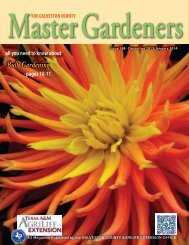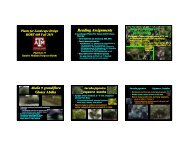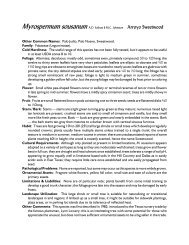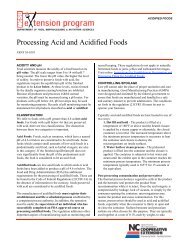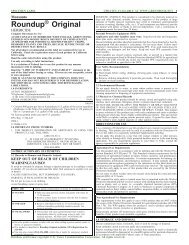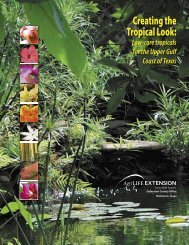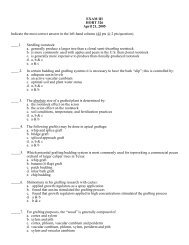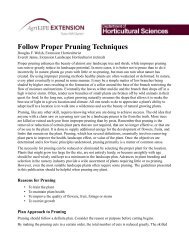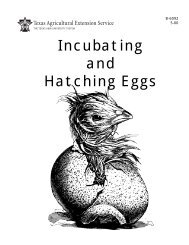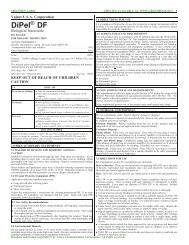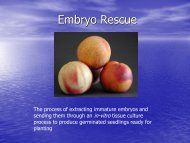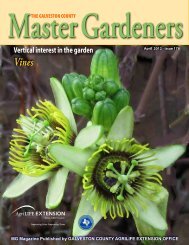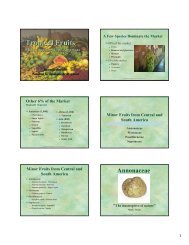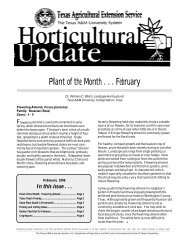Guide to PAS 2050 How to assess the carbon ... - Aggie Horticulture
Guide to PAS 2050 How to assess the carbon ... - Aggie Horticulture
Guide to PAS 2050 How to assess the carbon ... - Aggie Horticulture
You also want an ePaper? Increase the reach of your titles
YUMPU automatically turns print PDFs into web optimized ePapers that Google loves.
58<br />
Glossary<br />
Greenhouse gases (GHGs)<br />
Gaseous constituents of <strong>the</strong> atmosphere, both natural<br />
and anthropogenic, that absorb and emit radiation at<br />
specific wavelengths within <strong>the</strong> spectrum of infrared<br />
radiation emitted by <strong>the</strong> Earth’s surface, <strong>the</strong><br />
atmosphere, and clouds<br />
NOTE GHGs include <strong>carbon</strong> dioxide (CO 2<br />
), methane<br />
(CH 4<br />
), nitrous oxide (N 2<br />
O), hydrofluoro-<strong>carbon</strong>s (HFCs),<br />
perfluoro<strong>carbon</strong>s (PFCs) and sulfur hexafluoride (SF 6<br />
)<br />
Input<br />
Product, material or energy flow that enters a unit process<br />
Life cycle<br />
Consecutive and interlinked stages of a product system,<br />
from raw material acquisition or generation of natural<br />
resources <strong>to</strong> end of life, inclusive of any recycling or<br />
recovery activity<br />
Life cycle <strong>assess</strong>ment (LCA)<br />
Compilation and evaluation of inputs, outputs and<br />
potential environmental impacts of a product system<br />
throughout its life cycle<br />
Life cycle GHG emissions<br />
Sum of GHG emissions resulting from all stages of <strong>the</strong><br />
life cycle of a product and within <strong>the</strong> specified system<br />
boundaries of <strong>the</strong> product<br />
Mass balance<br />
Quantification of <strong>to</strong>tal materials flowing in<strong>to</strong> and out<br />
of a process<br />
Material contribution<br />
Contribution of any one source of GHG emissions <strong>to</strong><br />
a product of more than 1% of <strong>the</strong> anticipated life cycle<br />
GHG emissions associated with <strong>the</strong> product<br />
NOTE A materiality threshold of 1% has been established<br />
<strong>to</strong> ensure that very minor sources of life cycle GHG emissions<br />
do not require <strong>the</strong> same treatment as more significant sources.<br />
Offsetting<br />
Mechanism for claiming a reduction in GHG emissions<br />
associated with a process or product through <strong>the</strong><br />
removal of, or preventing <strong>the</strong> release of, GHG emissions<br />
in a process unrelated <strong>to</strong> <strong>the</strong> life cycle of <strong>the</strong> product<br />
being <strong>assess</strong>ed<br />
Output<br />
Product, material or energy that leaves a unit process<br />
Primary activity data<br />
Quantitative measurement of activity from a product’s<br />
life cycle that, when multiplied by an emission fac<strong>to</strong>r,<br />
determines <strong>the</strong> GHG emissions arising from a process<br />
NOTE Examples include <strong>the</strong> amount of energy used,<br />
material produced, service provided or area of land<br />
affected.<br />
Product(s)<br />
Any good(s) or service(s)<br />
NOTE Services have tangible and intangible elements.<br />
Provision of a service can involve, for example, <strong>the</strong><br />
following:<br />
•<br />
an activity performed on a consumer-supplied tangible<br />
product (e.g. au<strong>to</strong>mobile <strong>to</strong> be repaired);<br />
• an activity performed on a consumer-supplied intangible<br />
product (e.g. <strong>the</strong> income statement needed <strong>to</strong> prepare a<br />
tax return);<br />
• <strong>the</strong> delivery of an intangible product (e.g. <strong>the</strong> delivery of<br />
information in <strong>the</strong> context of knowledge transmission);<br />
• <strong>the</strong> creation of ambience for <strong>the</strong> consumer (e.g. in hotels<br />
and restaurants)<br />
• software consists of information and is generally<br />
intangible and can be in <strong>the</strong> form of approaches,<br />
transactions or procedures.<br />
Product category<br />
Group of products that can fulfil equivalent functions<br />
Product category rules (PCRs)<br />
Set of specific rules, requirements and guidelines for<br />
developing environmental declarations for one or<br />
more product categories according <strong>to</strong><br />
BS EN ISO 14040:2006<br />
Raw material<br />
Primary or secondary material used <strong>to</strong> produce a<br />
product<br />
Renewable energy<br />
Energy from non-fossil energy sources: wind, solar,<br />
geo<strong>the</strong>rmal, wave, tidal, hydropower, biomass, landfill<br />
gas, sewage treatment plant gas and biogases



